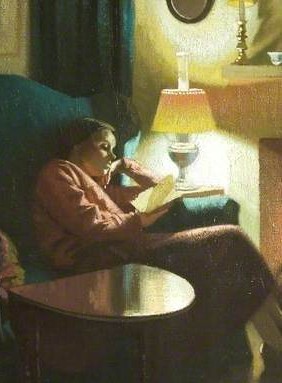Miss Buncle’s Book was D.E. Stevenson’s third novel. The first sunk without trace, the rest – more than forty in as many years – sold in their hundreds of thousands, over four million in Britain and over three million in the U.S.A. and Canada, where a loyal body of fans, DESsies, continues to keep her name very much alive. Persephone has done the same for her in the UK. Miss Buncle’s Book , the first of her novels to be reprinted here for fifty years, has been followed by Miss Buncle Married (Persephone Book No. 91) and The Two Miss Abbotts (Persephone Book No. 104).
The plot is simple, and of its time. It is the nineteen-thirties, and dividends are dwindling. Approaching forty, unmarried, Barbara Buncle finds herself worryingly short of money. Three solutions present themselves, keeping hens, taking in paying guests or writing a book. The first two are dismissed jointly by Miss B and her trusty servant, Dorcas. The twenty-first century reader is already transported back into that other country, where all but the poorest might keep a maid, and more fantastical still, where writing fiction could be a reliable source of income. I am often astonished researching the lives of Persephone authors how many in the nineteen-twenties and thirties took up writing ‘in order to support their families’. Plan C prevails. A novel is the answer, working title Chronicles of an English Village. Miss Buncle’s Book is not Miss Buncle’s book. We see barely two or three short extracts of Chronicles of an English Village, renamed by her publisher, for reasons that rapidly come apparent, Disturber of the Peace. Miss Buncle’s Book is a book about Miss Buncle writing a book.
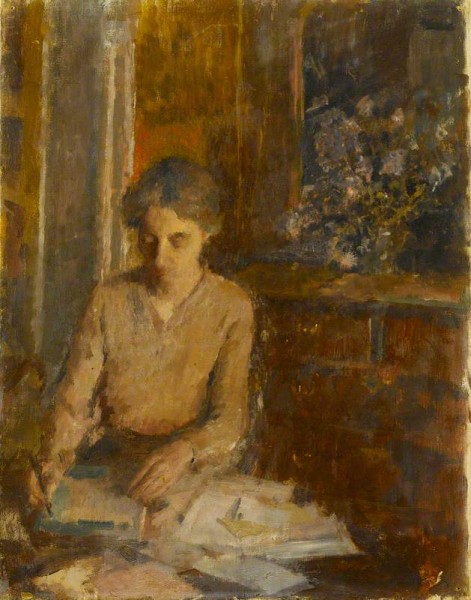
“Woman Writing a Letter” 1939 by Rupert Shephard. Arts Council Collection.
‘I can only write about people that I know. I can make them do things of course.’ Miss Buncle is conscious of her limitations, but fails to consider the inevitable consequences. The fact is that she doesn’t know many people. She lives in a small village and when the inhabitants of Silverstream open their library parcels, her pen portraits, accurate down to the last hair sprouting from the last mole, are instantly recognisable, to the fury of their subjects, none of whom are deceived by the thinly disguised names. Dr Rider, Mrs Silver, Mrs Mildmay, and the Nevis family are Dr Walker, Mrs Goldsmith, Mrs Bold and the Snowdons to the life. Copperfield is identical in every respect to Silverstream, apart from Miss B. herself reinvented as Elizabeth Wade, younger and better dressed. Nobody recognises her as the ‘old frump’ in Tanglewood Cottage, nor do they even suspect her of being John Smith (not the most imaginative nom de plume), ‘author’ of Disturber of the Peace.
Aline Templeton, in her introduction, remarks on the careful realisation of the village where Miss Buncle lives and writes, so careful that one of the DESsies has drawn a map of Silverstream.
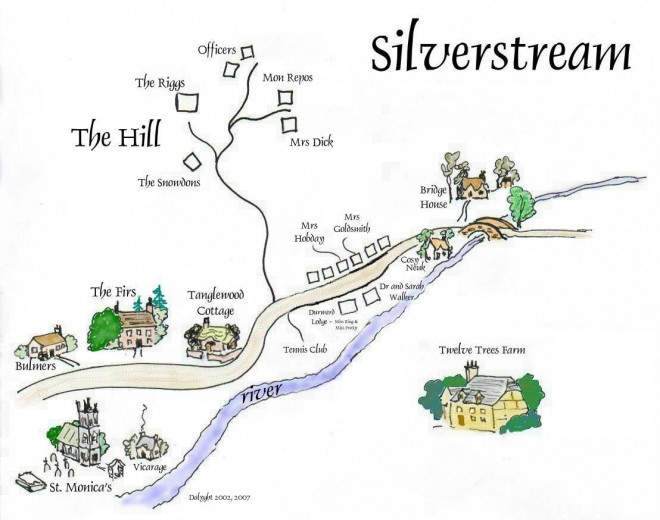
Another has made scale models of settings from the novels, sadly not from Miss Buncle’s Book, but one can almost picture D.E.S. arranging miniature houses into a model village, placing Bridge House across the modest main street from Cosy Neuk, so that Colonel Weatherhead and Mrs Bold might fulfil her plans for them, shifting Mon Repos up the hill, well away from the church, keeping a little distance between the predatory Mrs Goldsmith, and the new vicar; and tucking in Miss Buncle’s aptly named Tanglewood Cottage at the point where the road meets the river.
Born in Edinburgh, Dorothy Emily Stevenson lived all her life in Scotland, largely in Bearsden a suburb of Glasgow. An English village in the Home Counties was not familiar territory to her, but anyone who has ever lived in a village, or for that matter been part of a small community whose members have long ago established a hierarchy, and set the rules of behaviour, will recognise the characters and be familiar with the web of relationships, which Stevenson draws so deftly and with such humour. The cast includes the vicar, the doctor, the retired colonel, several widows, a spinster or two, a discreetly lesbian couple, some unmarried daughters, the self-appointed ‘lady of the manor’, with no manor and no title, but plenty of pretensions. Most but not all have comic potential, one is straightforwardly good (too good to feature in Miss B’s novel), one selfish to the point of cruelty, another wretchedly unhappy.
D.E.S. succeeds in giving each a voice, bringing them to life with as little as a single sentence. The young, rich, vicar, who attempts to live a life of poverty, but struggles with the cold, reflects wryly that ‘the apostles and saints had lived in warmer climes’. The preposterously haughty Mrs Featherstone Hogg, ‘tall and willowy and tired, so tired that you could not help feeling it was good of her to trouble to speak to you at all’, who prefers to conceal her days in the chorus line ( ‘I had a speaking part’), is troubled when her wealthy husband hints at a change in his will: ‘Agatha felt she could bear the loss [of Mr Featherstone Hogg] more courageously if she had all Edwin’s money to comfort her in her bereavement.’ D.E.S. captures both her awfulness and her affected delivery. Unimpressed by Miss Buncle’s success (she has received £100 advance from her publisher, about £6000 in today’s money), Dorcas is fiercely down to earth. ‘Authors indeed! – well, I’ll never read a book again but what I’ll think of the people as has had to put up with the author … Authors – poof! … but I never could abide hens neither.’ Mrs Greensleeves, the impoverished widow, even poorer than Miss B herself, owing to her extravagance, is in hot pursuit of the vicar: ‘He bored her frightfully but that could not be helped, the main thing was that he had money.’ The hard ringing tone pierces the fluffy exterior: Vivian Greensleeves surrounds herself with pink, pillows, bows, china: she ‘liked to think that they expressed her personality, and perhaps they did.’ D.E.S. is the mistress of understatement. A comma from her pen can be worth a dozen words. With the same withering economy, but less harshly, she dismisses the talents of the self-regarding Snowdon sisters, Isabella and Olivia, the one “poetical”, the other ‘musical”: ‘Olivia was full of Isabella’s latest poem; it was about a violet.’ If semi-colons could kill …
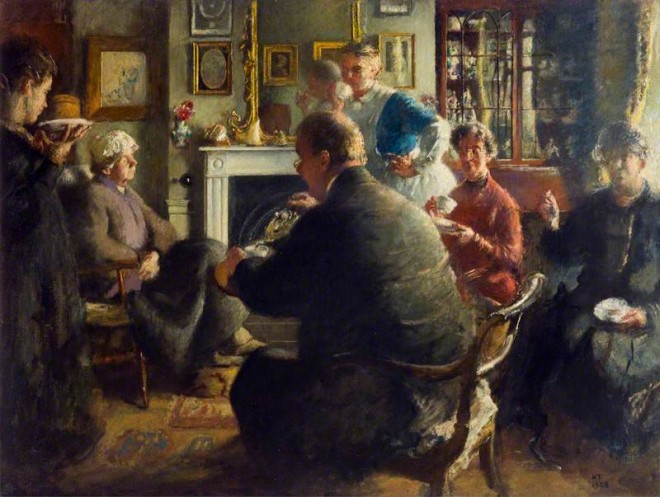
Aberdeen Art Gallery
The novel within a novel device allows D.E.S. the luxury of two authorial voices, her own and Miss Buncle’s. She leaves it to her alter-ego to encapsulate the unchallenged and unchallenging predictability of much village conversation: ‘“How nice for you – and for her of course,” exclaimed Barbara. She had lived for so long amongst these people and had suffered so many afternoon teas that she was able to say the expected thing without thinking about it at all. You simply put a penny in the machine and the expected thing came out at once, all done up in a neat little packet, and suitably labelled.’ It is in the ‘fictional’ Copperfield that some of the shabbier features of the village are exposed: the secrets petty and not so petty.
In both novels the line between fiction and fact (which is also of course fiction) is constantly shifting as social comedy and fairy-tale fantasy entwine. ‘It is the human element that interests me most in life’, wrote D.E.S.; she has Miss Buncle, quietly observing and listening to her neighbours, like ‘a sponge soaking up ambrosia’. Both are keen people-watchers. The telling detail is never missed: the cheese soufflé curdled by the maid of all work kept back on a Sunday, the shameful addition of pectin to the competition jam, the cracked drain pipe that brings the Colonel and Mrs Bold together, the Doctor’s armchair, fully broken in and so much more comfortable than his wife’s, too frail to have made much impression on hers. Lots of lovely period detail, too: the parcel of library books, the baker’s boy, the gossiping servants – even the doctor’s wife has three maids and a Nurse -, the dressmaker, Benger’s Food, false teeth being the norm for any woman over forty.
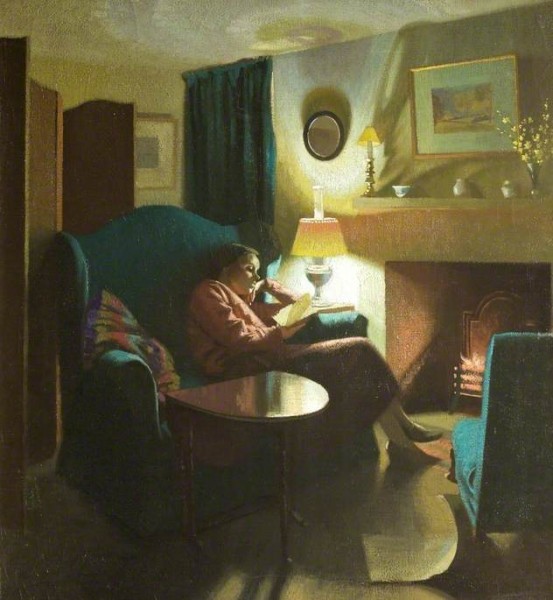
Brilliant social commentary, but both novels contain a strong element of what might now be called magic realism. In Miss Buncle’s book a Puck like figure is introduced. Miss B. insists that he is just an ordinary boy, but giving him the pipes of Pan, and the meddling powers of Robin Goodfellow rather gives the lie to this. Her Golden Boy is the ‘disturber’. He stirs things up, solves and creates problems. In Miss Buncle’s Book, it is Miss B. herself who is the disturber. Showing people as they are, rather than as they would like to see themselves, she gives courage to some, humility of sorts to others, magically extending her control beyond the pages of her book.
‘A novel about a woman who wrote a novel about a woman who wrote a novel …’, Miss Buncle’s publisher compares her writing to a tailor’s mirror, ‘in which the woman and her novel were reflected back and forth to infinity.’ The fictional publisher warns the fictional reader that it might make ‘your brain reel if you pursued the thought too far’, while adding reassuringly that ‘there was no need to do so, unless you wanted to, of course.’ And of course we do, not for the plot, which simple as it is – will the author of Disturber of the Peace (the novel written by the woman etc.) be discovered – does cause one’s head to spin rather – but for the sheer brilliance of the characters, and the improbable but thoroughly satisfying, and deserved, rewards and comeuppances that they are dealt.
